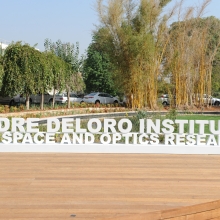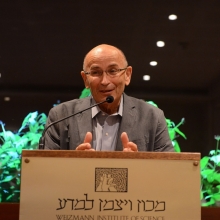Counter-culture
New research on bacteria is refining—and overturning—assumptions
Features

Increasing antimicrobial resistance threatens the lives of millions of people in Europe, North America, and Australia. In November 2018, the Organization for Economic Co-operation and Development (OECD) announced a five-part campaign to prevent the emergence and spread of antimicrobial resistance, including calling for better hygiene, ending over-prescription of antibiotics, rapid testing for viral versus bacterial infections, and delayed prescribing of antibiotics. This is an all-out, international assault on one of the biggest threats to modern medicine.
Certainly superbugs must be stopped. But there is more to bacteria than the bug-versus-drug war of attrition.
While the community of bacteria, fungi, viruses, and other microorganisms found in all multicellular organisms—known as the microbiome—generates a common cause for worry about infection and disease, the truth is that microbiota are actually an asset that can solve many health and environmental challenges. The new Knell Center for Microbiology—recently established thanks to the generosity of the Knell family of Los Angeles—will support Weizmann scientists as they explore this avenue and work to harness the power of ‘good’ microbial diversity to develop new medicines, understand trends in global ecology, and more.
Bacterial lessons in self-defense
One of the many things we can learn from bacteria, for instance, is how to defend and define the genome. Prof. Rotem Sorek, from the Department of Molecular Genetics, who heads the new Knell Center, is investigating destructive microbial warfare—the mechanisms by which microorganisms attack one another, and defend themselves against such attacks.
His subject is CRISPR-Cas, the adaptive immune system that bacteria use to defend themselves against viruses. CRISPR is a configuration of short, repetitive segments of DNA separated by unique sequences, which a bacterium acquires after having battled a particular virus—a kind of souvenir collection of viral DNA code for launching a defense the next time that virus attacks. The ‘Cas’ part of the name—i.e., CRISPR-associated proteins—helps CRISPR slice and dice a putative viral invader’s DNA to pieces.
CRISPR-Cas is an incredibly precise molecular scalpel with extraordinary therapeutic potential. The Sorek team recently discovered that antibiotic-resistant genes in disease-causing bacteria are controlled by special RNA elements that sense the presence of the antibiotic molecule and respond to it. The genes that confer antibiotic resistance are usually inactive, and are only activated by these special RNA elements. Might eliminating such elements be a job for CRISPR-Cas? The discovery offers new modalities of targeting and cancelling antibiotic resistance in pathogens.
Combatting cancer
Like Prof. Sorek, Dr. Ravid Straussman, from the Department of Molecular Cell Biology, is working to leverage the therapeutic potential of microbiota. Using novel methods developed in his lab to characterize and visualize bacteria found in tumor cells, he discovered that an enzyme expressed by bacteria in human pancreatic tumors was capable of metabolizing gemcitabine, the chemotherapy medication often used to treat pancreatic cancer—rendering it ineffective.
The discovery could be a major step forward for helping people with pancreatic cancer. Dr. Straussman and his team are now addressing whether such bacteria are found in other cancer types, and if so, what effects they might have on sensitivity to anti-cancer drugs.
Solving the global food crisis
Bacteria may also be poised to play a role in overcoming food scarcity in the face of a burgeoning global population. What if microorganisms could be manipulated to become energy sources?
This is the research question that drove Prof. Ron Milo and his team in the Department of Plant and Environmental Sciences to engineer bacteria that would create sugar from the greenhouse gas carbon dioxide. The scientists were able to insert the metabolic pathway for carbon fixation and sugar production into the bacterium E. coli. Carbon fixation is a natural process by which plants, algae, and certain bacteria (but not E. coli) pump carbon dioxide from the environment, add energy to it, and transform it into the sugars that are the essential starting points for life processes.
Remarkably, the Milo lab was able to reprogram E. coli using specially designed incubator tanks, in which they gradually nudged the bacteria into developing an appetite for carbon dioxide.
The ability to train E. coli to fix carbon could provide researchers with a new pathway for improving a basic but essential microbiological process. Although the bacteria currently release the gas back into the atmosphere, Prof. Milo hopes that in the future, these insights might help scientists manipulate microorganisms into soaking up atmospheric carbon dioxide and converting it into stored energy. This tool could also be instrumental in engineering new crops with carbon-fixing pathways, to ensure higher yields and improved adaptability.
See our climate, save our sea
Bacteria may also provide clues to the Earth’s climate history—and help in the understanding of climate change. Dr. Einat Segev and Prof. Assaf Vardi, also from the Department of Plant and Environmental Sciences, are investigating the unique behaviors of single-celled microorganisms and their interactions with their microenvironments. Both scientists study microscopic, single-celled algae known as coccolithophore. Inhabiting vast territories of the ocean, these algae gather into massive seasonal “blooms” that can cover hundreds of thousands of square kilometers in a matter of weeks. Within a few days, however, these algae meet their death—and the chalky platelets once covering their tiny bodies aggregate on the ocean floor, forming sediments and rocks. Annual blooms are frequently terminated by the infection of a specific large virus termed EhV.
Dr. Segev’s research has shown that a complex relationship between bacteria and these marine algae may be one of the driving factors behind their incredible growth and rapid bust. Moreover, the tug of war between bacteria and marine algae leaves traces in the geologic record that she believes can provide clues to our past climate conditions.
Meanwhile, Prof. Vardi is conducting research on how EhV infects algal cells, manipulates the host’s metabolism, and hijacks its cellular machinery—leading, eventually, to algal cell death. Understanding such mechanisms on the microscale may help clarify the large-scale impact of marine viruses on the demise of blooms. Given that algal blooms are responsible for half of the photosynthetic activity on Earth, EhV activity may serve as a kind of metabolic valve for the gigantic flux in organic carbon levels that affects all forms of marine life.
A healthy gut for a healthy life
The composition of a person’s gut microbiome has a significant impact on the development of obesity, insulin resistance, and liver inflammation. Weizmann Institute investigators Prof. Eran Elinav, of the Department of Immunology, and Prof. Eran Segal, of the Department of Computer Science and Applied Mathematics and the Department of Molecular Cell Biology, are exploring the connections among intestinal microbiota, the immune system, and human health. They have shown that a gut microbiome unbalanced by poor eating habits needs time to adjust, or else it can exacerbate post-dieting weight gain. At the same time, they have shown that diet and lifestyle are by far the most dominant factors shaping our microbiome composition—not our genes. For example, changes in sleep and feeding schedules have a marked effect on the microbiome and the normal daily cyclic behavior of gut bacteria populations. In other words, there is a lot that we can do right now to improve our health, by learning more about and improving what’s in our guts.
The missing 99%
“Bacteria have been around, adapting to life on Earth, since the dawn of our planet,” says Prof. Sorek. But while scientists have effectively harnessed the powers of microbes to solve many global challenges, recent data shows that only about 1% of the world’s microbial diversity has thus far been accessible to researchers. An astounding 99% of bacteria cannot grow in laboratory conditions, creating an enormous untapped field of microbiological diversity. Scientists at the Weizmann Institute—such as those highlighted here—are now studying this “missing 99%”—a vast opportunity for more groundbreaking discoveries.
Prof. Rotem Sorek is supported by the European Research Council, the Knell Family Center for Microbiology, and the David and Fela Shapell Family Foundation INCPM Fund for Preclinical Studies.
Dr. Ravid Straussman is supported by the European Research Council, the Fabricant-Morse Families Research Fund for Humanity, Mr. and Mrs. Andrew R. Morse, and the Rising Tide Foundation. Dr. Straussman is the incumbent of the Roel C. Buck Career Development Chair.
Prof. Ron Milo is supported by the Mary and Tom Beck - Canadian Center for Alternative Energy Research, the European Research Council, Dana and Yossie Hollander, The Larson Charitable Foundation, the Ullmann Family Foundation, and the Zuckerman STEM Leadership Program. Prof. Milo is the incumbent of the Charles and Louise Gartner Professorial Chair.
Dr. Einat Segev is supported by the Abramson Family Center for Young Scientists, The Benoziyo Endowment Fund for the Advancement of Science, the Merle S. Cahn Foundation, the Peter and Patricia Gruber Awards, the Estate of Jacqueline Hodes, the Estate of Fannie Sherr, and the Ullmann Family Foundation.
Prof. Assaf Vardi is supported by the De Botton Center for Marine Science, the European Research Council, Scott Eric Jordan, the Estate of Emile Mimran, the Edmond de Rothschild Foundations, the David and Fela Shapell Family Foundation INCPM Fund for Preclinical Studies, and the Bernard & Norton Wolf Family Foundation.
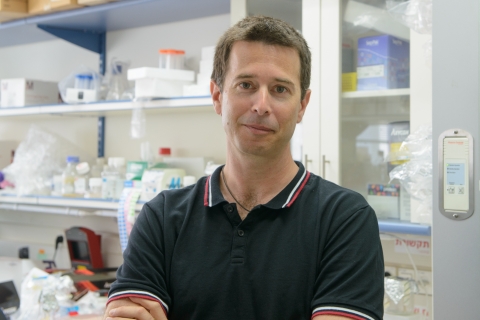
Prof. Rotem Sorek
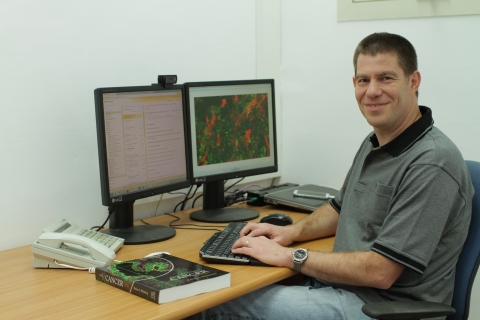
Dr. Ravid Straussman
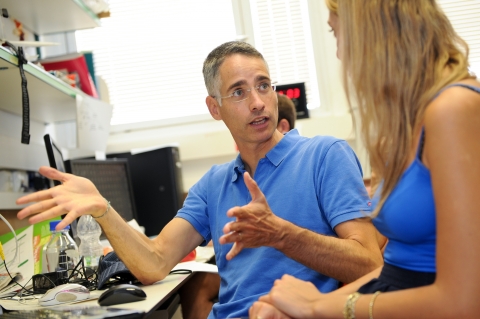
Prof. Ron Milo

Dr. Einat Segev



